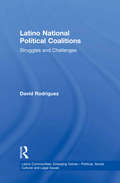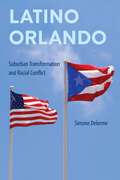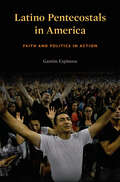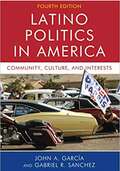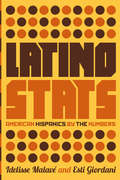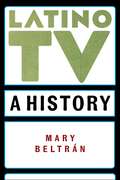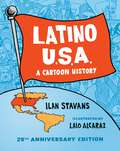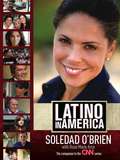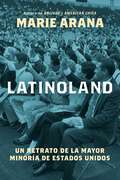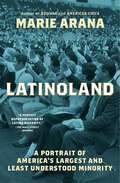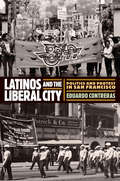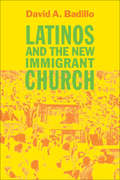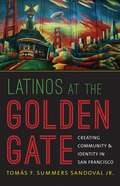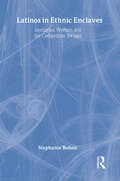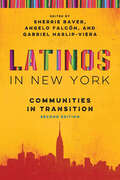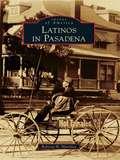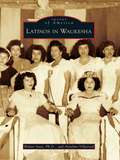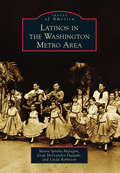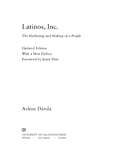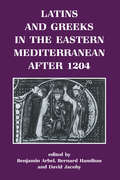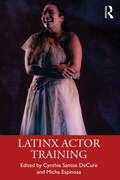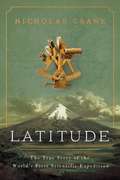- Table View
- List View
Latino National Political Coalitions: Struggles and Challenges (Latino Communities: Emerging Voices - Political, Social, Cultural and Legal Issues)
by David RodriguezThis study examines Latino national political coalitions in the United States with a focus on Chicanos, Puerto Ricans, and Cubans. It argues that Latino national political coalitions are an avenue of political empowerment for the Latino Community, but face social, economic, and political challenges in the Latino community.
Latino Orlando: Suburban Transformation and Racial Conflict (Southern Dissent)
by Simone DelermeInside the experiences of immigrants from Latin America and the CaribbeanLatino Orlando portrays the experiences of first- and second-generation immigrants who have come to the Orlando metropolitan area from Puerto Rico, Cuba, Mexico, Venezuela, Colombia, and other Latin American countries. While much research on immigration focuses on urban destinations, Simone Delerme delves into a middle- and upper-class suburban context, highlighting the profound demographic and cultural transformation of an overlooked immigrant hub. Drawing on interviews, observations, fieldwork, census data, and traditional and new media, Delerme reveals the important role of real estate developers in attracting Puerto Ricans—some of the first Spanish-speaking immigrants in the region—to Central Florida in the 1970s. She traces how language became a way of racializing and segregating Latino communities, leading to the growth of suburban ethnic enclaves. She documents not only the tensions between Latinos and non-Latinos, but also the class-based distinctions that cause dissent within the Latino population. Arguing that Latino migrants are complicating racial categorizations and challenging the deep-rooted Black-white binary that has long prevailed in the American South, Latino Orlando breaks down stereotypes of neighborhood decline and urban poverty and illustrates the diversity of Latinos in the region. A volume in the series Southern Dissent, edited by Stanley Harrold and Randall M. Miller
Latino Pentecostals in America: Faith and Politics in Action
by Gastón EspinosaThis &“excellent study&” of the Latino Pentecostal movement is &“an important resource for understanding the future of Christianity in North America&” (Choice). Every year an estimated 600,000 U.S. Latinos convert from Catholicism to Protestantism, a transformation spearheaded by the Pentecostal movement and Assemblies of God. Latino Assemblies of God leaders—and their 2,400 churches across the nation—represent a new and growing force in denominational, Evangelical, and presidential politics. In a deeply researched social and cultural history, Gastón Espinosa uncovers the roots and contemporary developments of this remarkable turn.Latino Pentecostals in America traces the Latino AG back more than a century, to the Azusa Street Revivals in Los Angeles and Apostolic Faith Revivals in Houston from 1906 to 1909. Espinosa describes the uphill struggles for indigenous leadership, racial equality, women in the ministry, social and political activism, and immigration reform. Their outspoken commitment to an active faith has led a new generation of leaders to combine the reconciling message of Billy Graham with the social transformation politics of Martin Luther King Jr. This eye-opening study explains why this group of working-class Latinos once called "the Silent Pentecostals" is silent no more. By giving voice to their untold story, Espinosa enriches our understanding of the diversity of Latino religion, Evangelicalism, and American culture.
Latino Politics In America: Community, Culture, And Interests
by John A. Garcia Gabriel Ramon SanchezThe fourth edition of this widely-used textbook introduces students to what it means to be a Latino American culturally and politically at a time of unprecedented challenges for America’s diverse and fastest-growing ethnic group. Garcia and Sanchez provide an in-depth examination of the individual communities that comprise the Latino culture, and how those bonds affect political development and decisions. With a look at voting, immigration, political engagement, and the critical public policies that constitute a Latino agenda, Garcia and Sanchez provide substantive insight on Latino pan-ethnic identity, growing policy issues, political participation, and the impact of changing Latino sub-groups.
Latino Stats
by Idelisse Malavé Esti GiordaniAt a time when politics is seemingly ruled by ideology and emotion and when immigration is one of the most contentious topics, it is more important than ever to cut through the rhetoric and highlight, in numbers, the reality of the broad spectrum of Latino life in the United States. Latinos are both the largest and fastest-growing racial/ethnic group in the country, even while many continue to fight for their status as Americans.Respected movement builder and former leader of the Tides Foundation Idelisse Malavé and her daughter, Celeste Giordani--a communications strategist for the Social Transformation Project--distills the profusion of data, identifying the most telling and engaging facts to assemble a portrait of contemporary Latino life with glimpses of the past and future. From politics and the economy to popular culture, the arts, and ideas about race, gender, and family, Latino Stats both catalogs the inequities that plague Latino communities and documents Latinos' growing power and influence on American life.An essential tool for advocates, educators, and policy makers, Latino Stats will be a go-to guidebook for anyone wanting to raise their awareness and increase their understanding of the complex state of our nation.
Latino TV: A History (Critical Cultural Communication)
by Mary BeltránThe history of Latina/o participation and representation in American televisionWhose stories are told on television? Who are the heroes and heroines, held up as intriguing, lovable, and compelling? Which characters are fully realized, rather than being cardboard villains and sidekicks? And who are our storytellers? The first-ever account of Latino/a participation and representation in US English-language television, Latino TV: A History offers a sweeping study of key moments of Chicano/a and Latino/a representation and authorship since the 1950s. Drawing on archival research, interviews with dozens of media professionals who worked on or performed in these series, textual analysis of episodes and promotional materials, and analysis of news media coverage, Mary Beltrán examines Latina/o representation in everything from children’s television Westerns of the 1950s, Chicana/o and Puerto Rican activist-led public affairs series of the 1970s, and sitcoms that spanned half a century, to Latina and Latino-led series in the 2000s and 2010s on broadcast, cable, and streaming outlets, including George Lopez, Ugly Betty, One Day at a Time, and Vida. Through the exploration of the histories of Latina/o television narratives and the authors of those narratives, Mary Beltrán sheds important light on how Latina/os have been included—and, more often, not—in the television industry and in the stories of the country writ large.
Latino USA: A Cartoon History
by Ilan StavansLatino USA represents the culmination of Ilan Stavans's lifelong determination to meet the challenges of capturing the joys, nuances, and multiple dimensions of Latino culture within the context of the English language. In this cartoon history of Latinos, Stavans seeks to combine the solemnity of so-called "serious literature" and history with the inherently theatrical and humorous nature of the comics. The range of topics includes Columbus, Manifest Destiny, the Alamo, William Carlos Williams, Desi Arnaz, West Side Story, Castro, Guevera, the Bay of Pigs, the Cuban Missile Crisis, Neruda, GarcÃMáuez, the Mariel Boatlift, and Selena. Stavans represents Hispanic civilization as a fiesta of types, archetypes, and stereotypes. These "clichéigurines" include a toucan (displayed regularly in books by GarcÃMáuez, Allende, and others), the beloved Latino comedian Cantinflas (known as "the Hispanic Charlie Chaplin"), a masked wrestler, and Captain America. These multiple, at times contradictory voices, each narrating various episodes of Latino history from a unique perspective, combine to create a carnivalesque rhythm, democratic and impartial. For, as Stavans states, "History, of course, is a kaleidoscope where nothing is absolute." Latino USA, like the history it so entertainingly relates, is a dazzling kaleidoscope of irreverence, wit, subversion, anarchy, politics, humanism, celebration, and serious and responsible history.
Latino Visions: Contemporary Chicano, Puerto Rican, and Cuban American Artists
by James D. CockcroftThe vibrancy and passion of contemporary Latino artists in the United States are celebrated in this book from award-winning writer James D. Cockcroft. Discover the context--political and social--in which their work has been created. Describes the evolution of Latino art in America through discussion of various artistic movements and important Latino artists.
Latino in America
by Soledad O'BrienNewsanchor Soledad O'Brien takes an in-depth look at today's Latino experience-- as her own-- with interviews, pictures, and travelogues about the country's largest minority...
LatinoLand (Spanish Edition): Un retrato de la mayor minoría de Estados Unidos
by Marie Arana&“Perfecta representación de la diversidad latina&” (The Washington Post), LatinoLand se nutre de cientos de entrevistas y de una prodigiosa investigación para ofrecernos tanto un vibrante retrato como la poco conocida historia de nuestra minoría más numerosa y de más rápido crecimiento, en &“una obra de profecía, simpatía y coraje&” (Junot Díaz, autor ganador del Premio Pulitzer).LatinoLand constituye una excepcional y completa panorámica de la América hispana basada en entrevistas personales, una profunda investigación y la experiencia vital de Marie Arana como latina. Hoy en día, los latinos representan el veinte por ciento de la población de Estados Unidos, cifra que sigue en aumento. Para 2050, los informes del censo prevén que uno de cada tres estadounidenses será de ascendencia latina. Pero los latinos no son un monolito. No representan a un único grupo. Los más numerosos son los mexicanos, puertorriqueños, dominicanos, salvadoreños y cubanos. Cada uno tiene un trasfondo cultural y político diferente. Los puertorriqueños, por ejemplo, son ciudadanos estadounidenses, mientras que algunos mexicano-estadounidenses nunca emigraron debido a que la frontera entre Estados Unidos y México se desplazó tras la invasión estadounidense de 1848, incorporando lo que hoy es todo el suroeste de Estados Unidos. Los cubanos llegaron en dos grandes oleadas: la de quienes escaparon del comunismo en los primeros años de Castro, muchos de los cuales eran profesionales y ricos, y la de los salieron con permiso en el éxodo del Mariel veinte años después, que representaban a algunos de los cubanos más pobres, incluso los presos. Como lo muestra LatinoLand, los latinos fueron de los primeros inmigrantes que llegaron a lo que hoy es Estados Unidos, algunos en el siglo XVI. Racialmente son diversos: una mezcla aleatoria de blancos, negros, indígenas y asiáticos. Alguna vez abrumadoramente católicos, entre ellos hay cada vez más protestantes y evangélicos. Abarcan desde empleadas domésticas y jornaleros hasta artistas de éxito, directivos de empresas y senadores estadounidenses. Antes demócratas en su mayoría, ahora votan cada vez más por los republicanos. En lo cultural son tan variados como cualquier inmigrante de Europa o Asia.
LatinoLand: A Portrait of America's Largest and Least Understood Minority
by Marie Arana&“A perfect representation of Latino diversity&” (The Washington Post), LatinoLand draws from hundreds of interviews and prodigious research to give us both a vibrant portrait and the little-known history of our largest and fastest-growing minority, in &“a work of prophecy, sympathy, and courage&” (Junot Díaz, Pulitzer Prize–winning author).LatinoLand is an exceptional, all-encompassing overview of Hispanic America based on personal interviews, deep research, and Marie Arana&’s life experience as a Latina. At present, Latinos comprise twenty percent of the US population, a number that is growing. By 2050, census reports project that one in every three Americans will claim Latino heritage. But Latinos are not a monolith. They do not represent a single group. The largest groups are Mexicans, Puerto Ricans, Dominicans, Salvadorans, and Cubans. Each has a different cultural and political background. Puerto Ricans, for example, are US citizens, whereas some Mexican Americans never immigrated because the US-Mexico border shifted after the US invasion of 1848, incorporating what is now the entire southwest of the United States. Cubans came in two great waves: those escaping communism in the early years of Castro, many of whom were professionals and wealthy, and those permitted to leave in the Mariel boat lift twenty years later, representing some of the poorest Cubans, including prisoners. As LatinoLand shows, Latinos were some of the earliest immigrants to what is now the US—some of them arriving in the 1500s. They are racially diverse—a random infusion of white, Black, indigenous, and Asian. Once overwhelmingly Catholic, they are becoming increasingly Protestant and Evangelical. They range from domestic workers and day laborers to successful artists, corporate CEOs, and US senators. Formerly solidly Democratic, they now vote Republican in growing numbers. They are as culturally varied as any immigrants from Europe or Asia. Marie Arana draws on her own experience as the daughter of an American mother and Peruvian father who came to the US at age nine, straddling two worlds, as many Latinos do. &“Thorough, accessible, and necessary&” (Ms. magazine), LatinoLand unabashedly celebrates Latino resilience and character and shows us why we must understand the fastest-growing minority in America.
Latinos and the Liberal City: Politics and Protest in San Francisco (Politics and Culture in Modern America)
by Eduardo ContrerasThe "Latino vote" has become a mantra in political media, as journalists, pundits, and social scientists regularly weigh in on Latinos' loyalty to the Democratic Party and the significance of their electoral participation. But how and why did Latinos' liberal orientation take hold? What has this political inclination meant—and how has it unfolded—over time?In Latinos and the Liberal City, Eduardo Contreras addresses these questions, offering a bold, textured, and inclusive interpretation of the nature and character of Latino politics in America's shifting social and cultural landscape. Contreras argues that Latinos' political life and aspirations have been marked by diversity and contestation yet consistently influenced by the ideologies of liberalism and latinidad: while the principles of activist government, social reform, freedom, and progress sustained liberalism, latinidad came to rest on promoting unity and commonality among Latinos.Contreras centers this compelling narrative on San Francisco—America's liberal city par excellence—examining the role of its Latino communities in local politics from the 1930s to the 1970s. By the early twentieth century, San Francisco's residents of Latin American ancestry traced their heritage to nations including Mexico, Puerto Rico, Nicaragua, El Salvador, Chile, and Peru. These communities formed part of the New Deal coalition, defended workers' rights with gusto, and joined the crusade for racial equality decades before the 1960s. In the mid- to late postwar era, Latinos expanded claims for recognition and inclusion while participating in movements and campaigns for socioeconomic advancement, female autonomy, gay liberation, and rent control. Latinos and the Liberal City makes clear that the local public sphere nurtured Latinos' political subjectivities and that their politicization contributed to the vibrancy of San Francisco's political culture.
Latinos and the New Immigrant Church
by David A. BadilloLatin Americans make up the largest new immigrant population in the United States, and Latino Catholics are the fastest-growing sector of the Catholic Church in America. In this book, historian David A. Badillo offers a history of Latino Catholicism in the United States by looking at its growth in San Antonio, Chicago, New York, and Miami. Focusing on twentieth-century Latino urbanism, Badillo contrasts broad historic commonalities of Catholic religious tradition with variations of Latino ethnicity in various locales. He emphasizes the contours of day-to-day life as well as various aspects of institutional and lived Catholicism. The story of Catholicism goes beyond clergy and laity; it entails the entire urban experience of neighborhoods, downtown power seekers, archdiocesan movers and shakers, and a range of organizations and associations linked to parishes. Although parishes remain the key site for Latino efforts to build individual and cultural identities, Badillo argues that one must consider simultaneously the triad of parish, city, and ethnicity to fully comprehend the influence of various Latino populations on both Catholicism and the urban environment in the United States.By contrasting the development of three distinctive Latino communities—the Mexican Americans, Puerto Ricans, and Cuban Americans—Badillo challenges the popular concept of an overarching "Latino experience" and offers instead an integrative approach to understanding the scope, depth, and complexity of the Latino contribution to the character of America's urban landscapes.
Latinos at the Golden Gate
by Tomás F. Summers SandovalBorn in an explosive boom and built through distinct economic networks, San Francisco has a cosmopolitan character that often masks the challenges migrants faced to create community in the city by the bay. Latin American migrants have been part of the city's story since its beginning. Charting the development of a hybrid Latino identity forged through struggle--latinidad--from the Gold Rush through the civil rights era, Tomas F. Summers Sandoval Jr. chronicles the rise of San Francisco's diverse community of Latin American migrants. This latinidad, Summers Sandoval shows, was formed and made visible on college campuses and in churches, neighborhoods, movements for change, youth groups, protests, the Spanish-language press, and business districts. Using diverse archival sources, Summers Sandoval gives readers a panoramic perspective on the transformation of a multinational, multigenerational population into a visible, cohesive, and diverse community that today is a major force for social and political activism and cultural production in California and beyond.
Latinos in Ethnic Enclaves: Immigrant Workers and the Competition for Jobs (Latino Communities: Emerging Voices - Political, Social, Cultural and Legal Issues)
by Stephanie BohonThis work explores the competition for jobs between different Latin American immigrant groups in the U.S. economy. Bohon's research looks at occupational status attainment among Latino groups in Miami and three other U.S. cities with flourishing Latino enclaves.
Latinos in New York: Communities in Transition (Latino Perspectives Ser.)
by Sherrie BaverSignificant changes in New York City's Latino community have occurred since the first edition of Latinos in New York: Communities in Transition was published in 1996. The Latino population in metropolitan New York has increased from 1.7 million in the 1990s to over 2.4 million, constituting a third of the population spread over five boroughs. Puerto Ricans remain the largest subgroup, followed by Dominicans and Mexicans; however, Puerto Ricans are no longer the majority of New York's Latinos as they were throughout most of the twentieth century.Latinos in New York: Communities in Transition, second edition, is the most comprehensive reader available on the experience of New York City's diverse Latino population. The essays in Part I examine the historical and sociocultural context of Latinos in New York. Part II looks at the diversity comprising Latino New York. Contributors focus on specific national origin groups, including Ecuadorians, Colombians, and Central Americans, and examine the factors that prompted emigration from the country of origin, the socioeconomic status of the emigrants, the extent of transnational ties with the home country, and the immigrants' interaction with other Latino groups in New York. Essays in Part III focus on politics and policy issues affecting New York's Latinos. The book brings together leading social analysts and community advocates on the Latino experience to address issues that have been largely neglected in the literature on New York City. These include the role of race, culture and identity, health, the criminal justice system, the media, and higher education, subjects that require greater attention both from academic as well as policy perspectives.Contributors: Sherrie Baver, Juan Cartagena, Javier Castaño, Ana María Díaz-Stevens, Angelo Falcón, Juan Flores, Gabriel Haslip-Viera, Ramona Hernández, Luz Yadira Herrera, Gilbert Marzán, Ed Morales, Pedro A. Noguera, Rosalía Reyes, Clara E. Rodríguez, José Ramón Sánchez, Walker Simon, Robert Courtney Smith, Andrés Torres, and Silvio Torres-Saillant.
Latinos in Pasadena (Images of America)
by Roberta H. MartinezHistories of Pasadena are rich in details about important citizens, time-honored traditions, and storied enclaves such as Millionaires Row and Lamanda Park. But the legacies of Mexican Americans and other Latino men and women who often worked for Pasadena's rich and famous have been sparsely preserved through the generations--even though these citizens often made remarkable community contributions and lived in close proximity to their employers. A fuller story of the Pasadena area can be provided from these vintage images and the accompanying information culled from anecdotes, master's theses, newspaper articles, formal and informal oral histories, and the Ethnic History Research Project compiled for the City of Pasadena in 1995. Among the stories told is that of Antonio F. Coronel, a one-time Mexican Army officer who served as California state treasurer from 1866 to 1870 and whose image graced the 1904 Tournament of Roses program.
Latinos in Waukesha (Images of America)
by Walter Sava Anselmo VillarrealWaukesha's Latino community continues to keep pace with the growth that has characterized Latino demographics in the last 20 years. About 15,000 Latinos are now Waukesha County residents, and there are very unique qualities ascribed to this community. A significant number of Latinos can trace their Waukesha roots to the early 1920s and 1930s. The vast majority of Latinos who came to Waukesha ended up working in foundries, and a significant number retired from those jobs. There are now many families who are third- and fourth-generation Latinos, and new arrivals continue to join friends and relatives already established in Waukesha.
Latinos in the Washington Metro Area (Images of America)
by Linda Robinson Jorge Hernandez-Fujigaki Maria Sprehn-MalagónThe Latino presence in the Washington, DC, metropolitan area has diverse roots and a rich history. The earlier residents were relatively small in number, but the Latino population increased dramatically in the late 20th century. Today, this unique Latino community is the 12th largest in the nation. While people of Salvadoran origin are the most numerous, this area is also home to those who hail from Mexico, Puerto Rico, Guatemala, Cuba, the Dominican Republic, Bolivia, Argentina, Chile, Colombia, Ecuador, Honduras, Nicaragua, Paraguay, Peru, Spain, Uruguay, and many other nations and cultures. This book highlights the early days of the Hispanic Festival, the Central American peace movement, the struggle for civil and immigrants� rights, and notable residents. With a shared immigrant experience and broad cultural bonds, these and many other Latino residents have transformed the Washington, DC, area.
Latinos, Inc.
by Arlene DávilaBoth Hollywood and corporate America are taking note of the marketing power of the growing Latino population in the United States. And as salsa takes over both the dance floor and the condiment shelf, the influence of Latin culture is gaining momentum in American society as a whole. Yet the increasing visibility of Latinos in mainstream culture has not been accompanied by a similar level of economic parity or political enfranchisement. In this important, original, and entertaining book, Arlene Dávila provides a critical examination of the Hispanic marketing industry and of its role in the making and marketing of U.S. Latinos. Dávila finds that Latinos' increased popularity in the marketplace is simultaneously accompanied by their growing exotification and invisibility. She scrutinizes the complex interests that are involved in the public representation of Latinos as a generic and culturally distinct people and questions the homogeneity of the different Latino subnationalities that supposedly comprise the same people and group of consumers. In a fascinating discussion of how populations have become reconfigured as market segments, she shows that the market and marketing discourse become important terrains where Latinos debate their social identities and public standing.
Latinos: A Biography of the People
by Earl ShorrisEarl Shorris's deeply moving narrative enlivened by biographical sketches of Mexican Americans, Cuban Americans, Puerto Ricans, and many others struggling with the burden of a rich and terrible history illuminates every aspect of the Latino experience in America, from language to education to social and political organization.
Latins and Greeks in the Eastern Mediterranean After 1204
by David Jacoby Bernard Hamilton Benjamin ArbelFirst published in 1989. Routledge is an imprint of Taylor & Francis, an informa company.
Latins, Greeks and Muslims: Encounters in the Eastern Mediterranean, 10th-15th Centuries
by David JacobyTrade, shipping, military conquest, migration and settlement in the eastern Mediterranean of the 10th-15th centuries generated multiple encounters between states, social and 'national' groups, and individuals belonging to Latin Christianity, Byzantium and the Islamic world. The nature of these encounters varied widely, depending on whether they were the result of cooperation, rivalry or clashes between states, the outcome of Latin conquest, which altered the social and legal status of indigenous subjects, or the result of economic activity. They had wide-ranging social and economic repercussions, and shaped both individual and collective perceptions and attitudes. These often differed, depending upon 'nationality', standing within the dominant or subject social strata, or purely economic considerations. In any event, at the individual level common economic interests transcended collective 'national' and cultural boundaries, except in times of crisis. The studies in this latest collection by David Jacoby explore the multiple facets of these eastern Mediterranean encounters and their impact upon individual economic activities, with special attention to the 'other', outsiders in foreign environments, foreign privileged versus indigenous traders, the link between governmental intervention, 'naturalization', and fiscal status, as well as the interaction between markets and peasants.
Latinx Actor Training
by Cynthia Santos DeCure Micha EspinosaLatinx Actor Training presents essays and pioneering research from leading Latinx practitioners and scholars in the United States to examine the history and future of Latino/a/x/e actor training practices and approaches. Born out of the urgent need to address the inequities in academia and the industry as Latinx representation on stage and screen remains disproportionately low despite population growth; this book seeks to reimagine and restructure the practice of actor training by inviting deep investigation into heritage and identity practices. Latinx Actor Training features contributions covering current and historical acting methodologies, principles, and training, explorations of linguistic identity, casting considerations, and culturally inclusive practices that aim to empower a new generation of Latinx actors and to assist the educators who are entrusted with their training. This book is dedicated to creating career success and championing positive narratives to combat pervasive and damaging stereotypes. Latinx Actor Training offers culturally inclusive pedagogies that will be invaluable for students, practitioners, and scholars interested in the intersections of Latinx herencia (heritage), identity, and actor training.
Latitude: The True Story of the World's First Scientific Expedition
by Nicholas CraneLatitude is a gloriously exciting tale of adventure and scientific discovery that has never been told before.Crane, the former president of the Royal Geographic Society, documents the remarkable expedition undertaken by a group of twelve European adventurer-scientists in the mid-eighteenth century. The team spent years in South America, scaling volcanoes and traversing jungles before they achieved their goal of establishing the exact shape of the Earth by measuring the length of 1 degree latitude at the equator. Their endeavors were not limited to this one achievement. Not only did their discovery open up the possibility for safe, accurate navigation across the seas, they also discovered rubber and quinine. With a narrative that reads like it was taken from the script of an adventure movie, Nicholas Crane brings to life a narrative that is a timely remind of how scientific discovery can change the world and our future. By knowing the shape of the earth we can create maps, survive the oceans, navigate the skies, and travel across the globe. Without latitude, maps and navigation wouldn&’t be accurate, lives would have been lost, and exact locations of cities and rivers would never be known. After ten grueling years in search of a magic number, the survivors returned to Europe with their historical discovery and fueled the public&’s interest in science. Twent-five years ago, Dava Sobel&’s bestselling Longitude was a global publishing phenomenon, yet it told only one half of the story. With Latitude, this cornerstone piece of our shared history is now complete with this tale of a trip that changed the course of human civilization. Filled with raw excitement and danger, Latitude brings the challenges that faced these explorer-scientists to vivid life.
